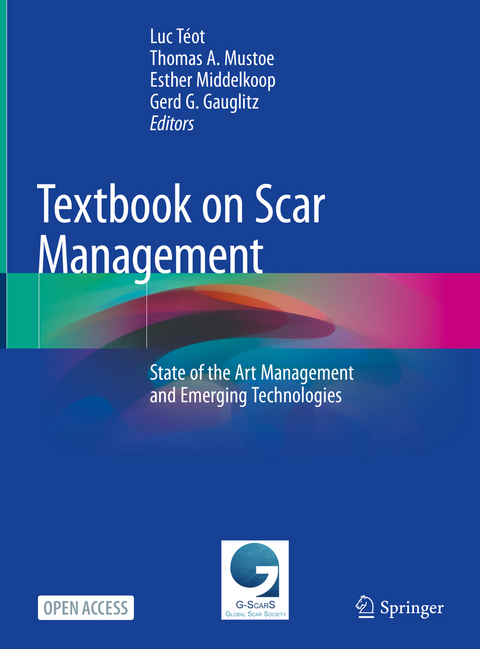
Textbook on Scar Management
Springer International Publishing (Verlag)
978-3-030-44765-6 (ISBN)
Luc Téot , MD, PhD, Prof., has been promoting wound healing and scar management since he founded the French Wound Healing Society in 1995. He was elected president of the European Tissue Repair Society (1998-2000) and then president of the World Union of Wound Healing Societies (2004-2008). He is also president of the Academy of Wound Technology, and was coordinator of the Scar Club (2006-2017). He has contributed to 12 international books as coeditor, chapter writer or editor. Thomas A. Mustoe , MD, FACS, is a former Professor and Chief of Plastic Surgery (1991-2010) at the Clinical Faculty Northwestern University, Feinberg School of Medicine, and recipient of a Wound Healing Society Lifetime Achievement Award. He was a member of the board of directors of the American Board of Plastic Surgery 2006-2012, and of the editorial boards of Plastic and Reconstructive Surgery, Wound Repair and Regeneration, Archives of Surgery, Journal of American College of Surgery, Journal of Surgical Research. Dr. Mustoe has been actively engaged in research on scarring involving both laboratory and clinical studies for 30 years, has received multiple NIH and Dept of Defense Grants ( USA), and has written over 230 peer-reviewed publications with a focus on scarring and wound healing. He holds several patents on new therapies for scarring and has further patents pending. Esther Middelkoop , PhD, has been a Professor of Skin Regeneration and Wound Healing at VU Medical Center Amsterdam since 2006. Her research topics include skin replacements and tissue- engineered skin, as well as clinical and preclinical burn and scar research. Esther Middelkoop participates actively in the European Tissue Repair Society (president 2003-2004), European Burns Association and Scar Club, now the Global Scar Society G-Scars (Montpellier). She regularly teaches at the Scar Academy (Antwerp, Belgium) and several Dutch Universities. Furthermore, she participated in the European FP7 consortium Euroskingraft. Gerd G. Gauglitz, MMS completed his medical training and specialization in dermatology and dermatosurgery at the National University of Singapore (NUS), the University of Texas Medical Branch (UTMB) and the Ludwig Maximilian University (LMU) in Munich, where he is employed as a senior physician and supervises the department of aesthetic dermatology and laser medicine. In addition, he is partner in a clinic specializing in dermatology, dermatosurgery and aesthetic medicine in Munich. Along with minmal invasive aesthetic procedures, Dr. Gauglitz's clinical and scientific work focuses on the treatment of excessive and atrophic scarring. He is a respected faculty member, has spoken at numerous national and international congresses, is the author of more than 100 publications in leading journals and text books and serves as the secretary of the German Society of Dermatosurgery (DGDC) and vice president of the Global Scar Society (G-ScarS).
lt;p>(see attached PDF for latest version)
Foreword.- Preface.- I Semiology of scars, classifications and scoring.- 1 Biology and scar formation.- 2 Epidemiology of scars and their consequences.- 3 Scar symptoms: itching, redness, thickness, contractures, colour, hyper/hypochromia, psychological disorders.- 4 International classification and semiology od scars.- 5 Scar evaluation scales (Vancouver, POSAS, Manchester).- 6 Assessment technologies (cutometer, laser Doppler, 3D imaging, stereophotogrammetry).- II Scars management and Evidence-based medicine.- 7 Non-invasive technologies (lasers fractional ER Yag, pulsed dye, fractional CO2, silicone, pressure garments, postop devices) and psychological management.- 8 Semi invasive technologies (injections corticoteroids, antimitotic, needling).- 9 Invasive techniques (surgery with local flaps, resurfacing, skin substitutes, microsurgical flaps, fat injections, others).- 10 Specific scar management depending on anatomical features (face, hair, breast, hand, joints, foot).- 11Cosmetic requirements depending on age and social considerations.- III State- of- the -Art Scar management technologies.- 12 Recently developed new technologies (mechanical, chemical).- 13 Cultural and traditional approaches.- 14 Cellular skin substitutes.- 15 New drugs for scar treatment.- 16 Vacuum massage in scar treatment.- 17 Shock wave therapy for scar treatment.- Subject Index.
| Erscheinungsdatum | 05.01.2021 |
|---|---|
| Zusatzinfo | XXV, 553 p. 231 illus., 228 illus. in color. |
| Verlagsort | Cham |
| Sprache | englisch |
| Maße | 210 x 279 mm |
| Gewicht | 1916 g |
| Themenwelt | Medizinische Fachgebiete ► Chirurgie ► Ästhetische und Plastische Chirurgie |
| Medizin / Pharmazie ► Medizinische Fachgebiete ► Dermatologie | |
| Medizin / Pharmazie ► Medizinische Fachgebiete ► Onkologie | |
| Schlagworte | atrophic scarring • burn physiotherapy • Burns • cutometer • hypertrophic scars • Keloid • open access • Reconstructive Surgery • scar classification • scar evaluation scales • scar remodelling • scar revision • Scars and 3D Imagery • scar stabilisation • Skin grafting • skin substitutes • Stereophotogrammetry • surgical oncology • wound healing • wounds |
| ISBN-10 | 3-030-44765-0 / 3030447650 |
| ISBN-13 | 978-3-030-44765-6 / 9783030447656 |
| Zustand | Neuware |
| Haben Sie eine Frage zum Produkt? |
aus dem Bereich


